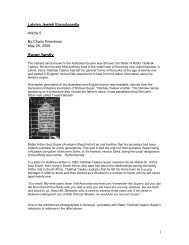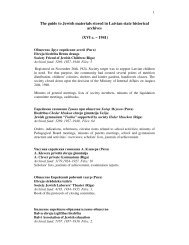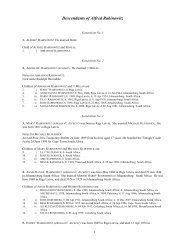Small Riga Ghetto
Small Riga Ghetto
Small Riga Ghetto
Create successful ePaper yourself
Turn your PDF publications into a flip-book with our unique Google optimized e-Paper software.
213<br />
ous in Kaiserwald. He was assisted by Raikin, whom the Jews tried to get rid<br />
of as soon as possible. Mr. X was succeeded by the SS murderers Sorge and<br />
Greschel, * who are already known to the reader, then by a Swiss prisoner, and<br />
after that by the SS man Blatterspiegel. These conditions forced many people<br />
to flee. The first ones to make the attempt were Boris Schmuljan, Gruschko<br />
(both of them were found and shot), Jeletzki, the engineer Kodesch, Monastirski<br />
and others. Schneidermann, well-known because of the Trud tobacco factory,<br />
threw himself under a train. "Iron Gustav" ordered that the corpse,<br />
whose head had been separated from the body, should be "punished" by being<br />
locked in a bunker for three days. Blatterspiegel ordered the hanging of a<br />
Czech Jew. These are only a few cases, but they are probably sufficient to illustrate<br />
the conditions at Spilve.<br />
In April 1944 a large work crew of men and women was transported to<br />
Ponewesch and Siauliai in Lithuania. They had to work at the airport there and<br />
lived in wooden huts. When the front moved closer, they were taken via Stutthof<br />
to Dachau. The physician Dr. Solomir was among those who died in Dachau.<br />
A small group of Lithuanian Jews was sent from Spilve to Daudzeva-Viesīte<br />
in Latvia to do logging. They worked there for seven months, and the following<br />
people risked an escape attempt: the Safir brothers, Miller and Winokur<br />
(all of them were from Kovno). After the Russians had advanced to this point<br />
as well, the work crew was moved to Liepāja, where fourteen more people<br />
escaped. In Liepāja the work crew had to work for the navy. Later it was combined<br />
with the small remainder of the Army Clothing Department (ABA) camp<br />
in <strong>Riga</strong>, transferred to the prison in Hamburg, and taken from there in groups<br />
to Bergen-Belsen. Among those who survived was my comrade Hermann.<br />
Of course extermination Aktionen were carried out in Spilve, as they were<br />
everywhere else, beginning with the children and ending with the old people.<br />
The usual haircut, which I have already described, was given to the inmates<br />
here too. The hair was collected and sent to Germany to be processed.<br />
On 6 August 1944 the remainder of the Spilve barracks camp was sent by<br />
ship to Germany. Only a small group remained to do the clearing up. But because<br />
they had sung Soviet songs they were punished by being sent to Kaiserwald.<br />
From there the "guilty ones" were sent to Stützpunkt to work in the notorious<br />
"potato Kommando" (see the chapter on Jumpravmuiža), where their lives<br />
ended.<br />
* [Ed.: Kroeschel]










